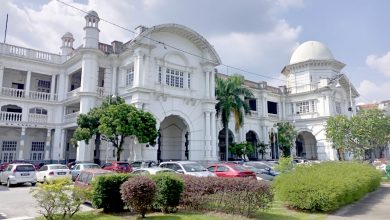Water, Water Everywhere
By Mariam Mokhtar


An excerpt from the book, “When Tin was King” said that in October 1918, Ipoh had not experienced much rain, but up-river, in Ulu Kinta, heavy rain had been falling and had filled the tributaries of the Kinta River.
The water worked its way along the river, and it is said that the shopkeepers were not aware of the impending floods, until they heard the noise of swirling, gushing water. They opened their windows, to find themselves surrounded by a mass of water, which seeped into their shops. Most of them were flooded with four feet deep of muddy water.
The loss to the commercial district was high. Damage to goods and offices, coupled with the disruption of services, wrecked the economy, at the time. Ipoh experienced other great floods in 1919 and in 1924.
In addition to the effect of the heavy rain, in the mountains, the activities of Perak’s main industries, tin mining and rubber, caused the rivers to silt easily.
Tin tailings flowed into the rivers, as did the wash from the rubber estates. The Kinta River had to be continually dredged, to keep the waterway clear, as river traffic was the main form of transport for goods and people, before the advent of the railway.
In December 2014, various parts of Malaysia were flooded. Many people claim, it was one of the worst floods, in living memory.
Barely a year later, many places were hit by flash floods, and hundreds of people were evacuated to safety, in Perak. On November 21, 2015, the Fire and Rescue Department director, Yahya Madif, said that the number of flood victims, had risen from 286, on November 20, to 315, a day later. Flash floods had hit a variety of places, such as Batu Merah, Bagan Serai and Batu Gajah.
The heavy rains, during the monsoon season, are frequently blamed for causing the floods, but there are other contributory factors.
If we were to look around us, at homes in the cities, we observe that many people pave their front gardens. One, or two homes, would not make much difference, but when row upon row of houses do the same, the rain cannot seep into the ground.
We have a furious pace of housing development. At times, one wonders if the drainage is adequate. Certain housing estates are known to be prone to flooding.
Another problem is the monsoon drains and culverts which are not cleared of logs, branches and other detritus, regularly. When the rubbish is not cleared, the passage of water is impeded, so the water will ultimately break its banks.
Our rivers carry silt, from upriver, and if the rivermouth is not dredged, it stands to reason that flooding will occur along its course.
Our mangrove swamps act like sponges, and any excess water, from a tsunami or flooding is absorbed by the roots of the plants in the mangrove tidal estuary. If we continually cut down the mangrove trees, to convert the land into oil-palm plantations, or prawn farms, the natural soak-away qualities of the mangrove will be lost.
Indiscriminate logging of our forests accelerates soil erosion and weathering of the soil. The jungle bed filters water, and the roots of trees, hold soil in place. Logging removes the trees, and exposes the soil, so that both the leaves and roots of the trees, are not present, to absorb the excess moisture.
The resultant flooding may cause the natural habitats, of certain species, to be destroyed, with a loss of biodiversity and the possibility that some species of flora and fauna become extinct.
Logging trails disturb the soil structure, and hunting, by the timber workers all contribute towards a decline in the wildlife population. Water which falls on the compacted logging trails, is washed into rivers, thus reducing the water quality of the rivers.
With the rapid pace of development, are we building on sites which are unsuitable for people to live? Are we building on floodplains, or areas which are prone to flooding, at certain times of the year? Sometimes, it is best to leave the mangrove swamps, and other floodplains alone, to do what nature intended them to do.


